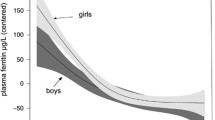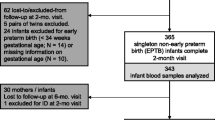Abstract
The iron status and diet of Inuit infants living in northern Quebec who were part of a prospective cohort study was described. The prevalence of anemia (hemoglobin values >2SD below the reference mean) was 21.1% (23/109), 47.4% (55/116) and 37.7% (46/122) at 2, 6 and 12 months, respectively. The corresponding prevalence of microcytic anemia was 0.0%, 4.3% and 21.3%. At 2, 6 and 12 months, iron-deficiency anemia (serum ferritin < 10 μg/L coupled with anemia) was present in 1.3% (1/79), 24.4% (21/86) and 26.3% (25/95) of infants, respectively. Compared with breastfeeding, the odds ratio for iron deficiency (serum ferritin < 10 μg/L) for bottle-feeding with cows’ milk or low iron formula was 3.02 (95% CI 1.25–7.27) at 6 months and 3.05 (95% CI 1.28–7.28) at 12 months. This study shows iron-deficiency anemia to be a problem in Inuit infants as young as 6 months old. Breastfed infants were better protected against iron deficiency than infants fed cow’s milk or low-iron formula.
Résumé
Le statut nutritionnel en fer et les apports alimentaires chez les nourrissons vivant dans le nord du Québec qui faisaient parti d’une étude de cohorte ont été décrit. La prévalence de l’anémie (hémoglobine >2SD au-dessous de la référence moyenne) était de 21,1 % (23/109), 47,4 % (55/116) et 37,7 % (46/122) à 2, 6 et 12 mois respectivement. La prévalence correspondante d’anémie microcitique était de 0,0 %, 4,3 % et 21,3 %. À 2, 6 et 12 mois, l’anémie dû à la carence en fer (sérum ferritin < 10μg/L couplé à l’anémie) était respectivement présente chez 1,3 % (1/79), 24,4 % (21/86) et 26,3 % (25/95) des nourrissons. Comparativement à l’allaitement, les chances de carence en fer pour les enfants nourrissons nourris au lait de vache ou au lait maternisé faible en fer, était de 3,02 (95 % CI 1,25-7,27) à 6 mois et 3,05 (95 % CI 1,28–7,28) à 12 mois. Cette étude démontre que l’anémie dû à la carence en fer est un problème chez les nourrissons Inuits aussi jeune que 6 mois. Les nourrissons allaités étaient mieux protégés contre la carence en fer que les nourrissons nourris au lait de vache ou au lait maternisé faible en fer.
Similar content being viewed by others
References
Walter T, De Andraca I, Chadud P, Perales, CG. Iron deficiency anemia: Adverse effects on infant psychomotor development. Pediatrics 1989;84:7–17.
Lozoff B, Jimenez E, Wolf, AW. Long-term developmental outcome of infants with iron deficiency. New Engl J Med 1991;325:687–94.
Dewailly E, Ayotte P, Bruneau S, et al. Inuit exposure to organochlorines through the aquatic food chain in Arctic Quebec. Environ Health Perspect 1993;101:618–20.
Dewailly E, Bruneau S, Ayotte P, et al. Health status at birth of Inuit newborn prenatally exposed to organochlorines. Chemosphere 1993;27:359–66.
Dallman PR, Yip R, Oski, FA. Iron deficiency and related nutritional anemias. In: Nathan DG, Oski FA (Eds.), Hematology of Infancy and Childhood. Philadelphia: WB Saunders, 1993;413–50.
Dallman, PR. In: Rudolph A (Ed.), Pediatrics. New York: Appleton-Century-Crofts, 1977;1111.
Emond AM, Hawkins N, Pennock C, Golding J. Haemoglobin and ferritin concentrations in infants at 8 months of age. Arch Dis Child 1996;74:36–39.
Dewey KG, Cohen RJ, Rivera LL, Brown, KH. Effects of age of introduction of complementary foods on iron status of breast-fed infants in Honduras. Am J Clin Nutr 1998;67:878–84.
Olivares M, Walter T, Osorio M, et al. Anemia of a mild viral infection: The measles vaccine as a model. Pediatrics 1989;84:851–55.
Reeves JD, Yip R, Kiley VA, Dallman, PR. Iron deficiency in infants: The influence of mild antecedent infection. J Pediatr 1984;105:874–79.
MacMillan HL, MacMillan AB, Offord DR, Dingle, JL. Aboriginal health. CMAJ 1996;155:1569–78.
Levitt C, Doyle-MacIsaac M, Grava-Gubins I, et al. Our strength for tomorrow: valuing our children. Part 7: Aboriginal children. Report of the CFPC’s Task Force on Child Health. Can Fam Phys 1998;44:358–68.
Marcus AH, Schwartz J. Dose-response curves for erythrocyte protoporphyrin vs blood lead: Effects of iron status. Environmental Research 1987;44:221–27.
Tsuji LJS, Nieboer E. Lead pellet ingestion in First Nation Cree of the Western James Bay region of northern Ontario, Canada: Implications for a nontoxic shot alternative. Ecosystem Health 1997;3:54–61.
Carey, LS. Lead shot appendicitis in northern native people. J Can Assoc Radiol 1977;28:171–74.
Willows ND, Morel J, Gray-Donald K. Prevalence of anemia among James Bay Cree infants of northern Quebec. CMAJ 2000;162:323–26.
Hallberg L, Brune M, Rossander L. Effect of ascorbic acid on iron absorption from different types of meals. Studies with ascorbic-acid-rich foods and synthetic ascorbic acid given in different amounts with different meals. Human Nutrition - Applied Nutrition 1986;40:97–113.
Bjorn-Rasmussen E, Hallberg L. Effect of animal proteins on the absorption of food iron in man. Nutr Metab 1979;23:192–202.
Lopez-Alarcon M, Villalpando S, Fajardo A. Breast-feeding lowers the frequency and duration of acute respiratory infection and diarrhea in infants under six months of age. J Nutr 1997;127:436–43.
Dewey KG, Heinig MJ, Nommsen-Rivers, LA. Differences in morbidity between breast-fed and formula-fed infants. J Pediatr 1995;126:696–702.
Ball TM, Wright, AL. Health care costs of formula-feeding in the first year of life. Pediatrics 1999;103:870–76.
Author information
Authors and Affiliations
Corresponding author
Additional information
Dewailly received financial support for the original cohort study (1989–1990) from the Quebec Ministry of Health. Willows received the following graduate student funding: International Order of Daughters of the Empire (IODE) War Memorial Post Graduate Scholarship and Fonds de la recherche en santé du Québec (FRSQ).
None of the authors have affiliations that could create a conflict of interest in the reporting or interpretation of research finding.
Rights and permissions
About this article
Cite this article
Willows, N.D., Dewailly, É. & Gray-Donald, K. Anemia and Iron Status in Inuit Infants from Northern Quebec. Can J Public Health 91, 407–410 (2000). https://doi.org/10.1007/BF03404818
Received:
Accepted:
Published:
Issue Date:
DOI: https://doi.org/10.1007/BF03404818




